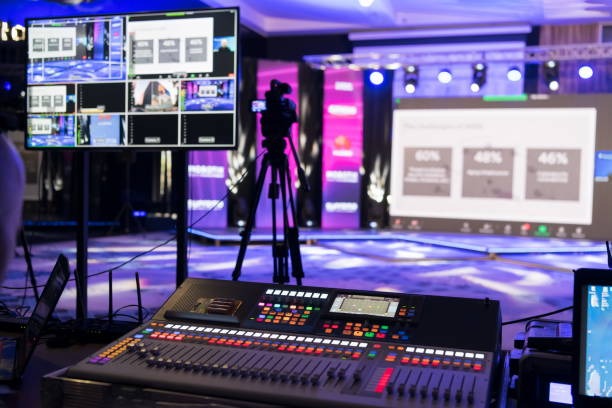Look around. Every major event, product launch, or corporate summit you’ve attended probably had one thing in common—powerful visuals and flawless sound.
That’s not luck. That’s audio visual production at work.
It’s the hidden force behind the scenes. The reason a brand launch feels cinematic. The reason a conference feels alive. The reason your audience doesn’t just watch—but feels.
Let’s break down why AV production is no longer optional. It’s the backbone of modern communication.
Contents
- 1 What Audio Visual Production Really Means
- 2 Why Every Business Should Care
- 3 Entertainment and Immersion
- 4 Startups and the Power of First Impressions
- 5 Equipment That Makes It Happen
- 6 The Human Factor: Talent and Teamwork
- 7 The Role of Gadgets in Modern AV
- 8 Hybrid Events: The New Normal
- 9 Technology Meets Storytelling
- 10 The Cost of Cutting Corners
- 11 Scaling AV for Every Size
- 12 Sustainability in AV
- 13 The Future of Audio Visual Technology
- 14 Why It Matters More Than Ever
- 15 Final Thoughts
What Audio Visual Production Really Means
People think “audio visual” just means speakers and screens. It’s far more than that.
Audiovisual production combines technology, creativity, and logistics. It’s about crafting experiences through sound, light, motion, and media.
You’re not just amplifying sound. You’re amplifying emotion.
It includes:
- Professional sound systems.
- High-definition projectors and LED screens.
- Lighting design and control systems.
- Cameras, switchers, and media servers.
- Live streaming and broadcasting tech.
When it all works together, it creates energy. The kind you can feel in your chest. The kind that turns a message into an experience.
Why Every Business Should Care
Businesses used to rely on slideshows. That era is over.
Today, attention is currency. Audiovisual production helps brands capture and keep it.
At conferences, trade shows, or investor meetings, high-quality AV turns ordinary content into storytelling. It gives your brand authority. It makes you look polished, prepared, and professional.
When a CEO takes the stage, the way the lights hit matters. The way the audio transitions into the next segment matters. Every cue sends a message.
Because in business, presentation is perception.
Entertainment and Immersion
Entertainment events live and die by production quality. Period.
Concerts, film festivals, and esports tournaments—all depend on AV precision.
- LED walls sync to beats.
- Sound systems move thousands in rhythm.
- Lighting rigs build tension before the drop.
Behind that experience is a team of AV engineers, designers, and operators making sure every pixel and decibel syncs perfectly.
That’s not guesswork. It’s a strategy.
Entertainment today is hybrid. You’re performing for a live audience and a global stream. Audiovisual production bridges both. It delivers the same energy through every channel.
Startups and the Power of First Impressions
Startups fight for attention. Investors, clients, users—it’s all about the pitch.
A well-produced event gives startups an edge. Clean visuals. Balanced sound. Dynamic transitions. It all signals professionalism.
AV isn’t decoration. Its credibility.
Imagine two founders presenting. One fumbles through low-quality slides with bad audio. The other uses clean visuals, confident lighting, and smooth media transitions.
Who would you invest in?
Exactly.
Equipment That Makes It Happen
Good AV doesn’t happen by accident. It’s built from precision tools.
Here’s what drives top-tier production:
1. Audio Systems
Microphones. Mixers. Speakers. Wireless setups. Every sound must be clean, clear, and controlled. Feedback or distortion kills momentum instantly.
2. Video Systems
Cameras and switchers capture every moment. LED walls and projectors display it in perfect sync. The goal: crisp visuals that feel alive.
3. Lighting Design
Lighting directs attention. It highlights key moments. It sets emotion. Warm tones inspire trust. Cool tones create focus.
4. Control Centers
The brains of it all. A central console manages lighting, sound, and visuals in real time. It’s where coordination meets creativity.
5. Streaming and Recording Tools
Modern events live online. Whether it’s a corporate town hall or a global summit, live streaming gear ensures your audience connects anywhere.
Every piece of equipment has one mission—make the story unforgettable.
The Human Factor: Talent and Teamwork
Technology alone doesn’t create magic. People do.
An AV production team is a mix of engineers, designers, and producers who turn ideas into moments.
- The audio engineer manages levels and clarity.
- The video technician controls feeds and transitions.
- The lighting director sets the tone and timing.
- The producer connects it all into one flow.
They work in sync, sometimes down to the second. One wrong cue can derail an entire presentation.
That’s why professional AV production matters. It’s precision under pressure.
The Role of Gadgets in Modern AV
AV tech keeps evolving.
Tiny wireless microphones. 4K projectors. AI-assisted mixers. Even portable LED panels that adjust color temperature automatically.
Gadgets make production leaner and smarter.
New gear allows faster setups and cleaner outputs. For example:
- Portable switchers let producers control multiple feeds from tablets.
- Digital soundboards auto-adjust frequencies to prevent echo.
- Smart lighting systems react to music or voice commands.
AV isn’t static. It’s innovation in motion.
Hybrid Events: The New Normal
COVID changed how events work. Even now, hybrid formats dominate.
You’ve got people in the room. Others online. Both expect the same experience.
That’s a challenge—and a massive opportunity.
Audiovisual production makes hthe ybrid seamless. It merges physical and digital audiences. Cameras capture the speaker. Audio feeds go through digital mixers. Streams get encoded in real time.
Done right, there’s no lag, no disconnect. Everyone feels included.
That’s the power of integration.
Technology Meets Storytelling
AV isn’t about showing tech. It’s about telling stories through tech.
Lighting builds emotion. Audio builds rhythm. Video builds context.
When you fuse them, you get something powerful—narrative immersion.
This is what separates good events from unforgettable ones. The audience doesn’t just see slides—they feel a journey.
And that emotional connection? It drives engagement, memory, and loyalty.
The Cost of Cutting Corners
Poor AV ruins great content.
You can have the smartest speaker, the best strategy, the most inspiring message, but if the mic cuts out or the visuals glitch, the audience checks out.
Bad AV says, “We didn’t care enough to prepare.”
Good AV says, “We respect your time.”
That’s the difference between noise and impact.
Scaling AV for Every Size
Not every company needs stadium-level production. But every company needs clarity.
You can scale AV to fit your space and goals:
- Small meeting rooms: Portable projectors and wireless soundbars.
- Mid-size events: Dual screens, mic arrays, and lighting rigs.
- Large conferences: Full control systems, multi-camera setups, live streaming.
The point isn’t extravagance. Its effectiveness.
Whatever the scale, professional AV makes communication seamless.
Sustainability in AV
Modern audiovisual production is going green.
LED lighting uses less energy. Digital setups reduce physical waste. Remote production minimizes travel.
Many companies now use reusable rigging systems and modular setups to save materials.
Sustainability isn’t just a buzzword. It’s part of smart business. It saves money and builds a reputation.
The Future of Audio Visual Technology
AV tech is merging with AI and automation.
Imagine systems that self-calibrate for optimal sound. Cameras that track speakers automatically. Lighting that adjusts to emotion through biometric feedback.
It’s already happening.
AV companies are integrating sensors, data analytics, and real-time feedback into their workflows. That means smarter, faster, more personalized experiences.
The next era of audiovisual production isn’t just about equipment. It’s about intelligence.
Why It Matters More Than Ever
In a world full of screens, visuals, and information overload, clarity wins.
AV gives clarity. It gives presence. It creates a connection.
Whether you’re a startup founder pitching investors or a global brand launching innovation, your story deserves the best stage possible.
Because sound and visuals don’t just support the message—they become it.
Final Thoughts
Audiovisual production isn’t behind the scenes anymore. It is the scene.
It drives how people see, hear, and feel your message. It’s where technology meets creativity and where communication becomes experience.
If you want your brand, event, or product to stand out, don’t treat AV like a detail. Treat it like your competitive advantage.
And if you’re curious about how professionals create seamless, high-impact experiences, explore audio visual production in depth.
Because when everything clicks—light, sound, and motion—you don’t just present. You command attention.




